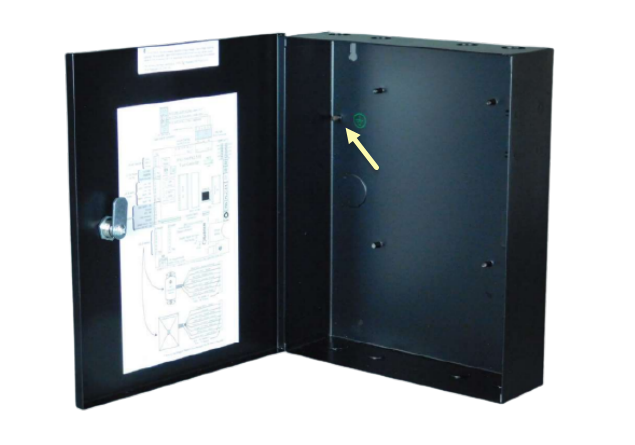Earth Grounding Keri NXT-MSC Controllers
1.0 Introduction
You should make a quality earth ground connection to all Keri NXT-MSC 2D or 4D controllers to ensure the best possible operating conditions for the controllers. An earth ground brings all electrically neutral lines to the earth's surface potential (essentially to a zero potential). Without a quality earth ground connection, the access control system may appear to operate correctly, but can be extremely susceptible to transients and electromagnetic interference on data and power lines. In addition, while the system may appear to work correctly now, improper or non-existent earth grounding can cause erratic system reliability in the future, resulting in possible equipment failure and/or more frequent service calls.
This document applies to the following Keri products:
- Keri Standard NXT 2D/4D controllers.
- NXT-MSC (Mercury-Powered) 2D/4D controllers.
2.0 Proper Earth Ground Benefits:
- An earth ground protects a controller from electrical transients such as power surges (which also provides a degree of safety for an installer).
- An earth ground provides a path to ground for electrical interference helping to minimize data and communication problems for controller to host communications.
3.0 Typical Sources for an Earth Ground are:
- copper shrouded ground rod
- cold water pipe (must be a metal pipe, galvanized or copper – it cannot be PVC)
- steel building framing member (however, the building's frame must be embedded in the earth)
- electrical system ground (at the breaker/fuse box)
- telephone system ground
4.0 Earth-Ground Cable Type
- a single conductor, solid strand, AWG 18 wire (a larger gauge is always acceptable)
- green with a yellow tracer (but are also often solid green)
5.0 When Making an Earth-Ground connection:
- Each controller should have its own, unique earth ground. Do not daisy-chain earth ground connections between multiple controllers.
- When routing the earth ground wire, make it the shortest path to ground as possible.
- Verify a solid earth ground connection has been made before turning on controller power for the first time.
- Periodically verify the quality of the controller's earth ground connection.
6.0 Make the Earth-Ground Connection at:
6.1 The Controller's Metal Enclosure
You should make a quality earth-ground connection to the metal enclosure lug (which displays an adjacent earth-ground symbol).

This good-quality earth-ground at the enclosure lug will provide an earth-ground for the entire enclosure - and will therefore ground anything that is connected to the metal enclosure - (the four metal screws at each corner of the PCB) - plus, through circuitry on the PCB, this includes anything connected to the lug marked J6 or pin 3 of the TB10 power connector.
In addition, the enclosure itself must be earth grounded to a good quality ground point external to the enclosure for a complete path to ground.
6.2 At the Controller's Earth-Ground Lug
NXT controllers have Ground Lug J6 at the top of the PCB near the TB10 power connector. Make your NXT earth ground connection directly to this lug.
7.0 Grounding RS-485 Devices and Readers
Also, the shield/drain wire of any reader/peripheral cables MUST be terminated to one of the following points-any corner screw attaching the controller to the enclosure, Pin 3 of TB10, the green ground lug (J6) on the controller, or the ground lug of the enclosure. Failure to properly earth ground the reader/peripheral drain wire may result in unreliable communication or operation of the attached peripheral.
The following diagram illustrates correctly grounding an NXT reader at the controller.
Related Articles
NXT-MSC 2D/4D Controller Hardware Installation Guide
1.0 Introduction This document contains basic information for the installation of the NXT-MSC (Mercury-Powered) 2D (2-door) and 4D (4-door) controllers. Notes: The NXT-MSC controller has recently been updated from a green PCB to a black colored PCB. ...NXT-MSC 2D Data Sheet
NXT-MSC (Mercury-Powered) 2-Door Controller Data Sheet (attached)NXT-MSC 4D Data Sheet
NXT-MSC (Mercury-Powered) 4-Door Controller Data Sheet (attached)NXT-MSC Hardware Cable Requirements
The attached document provides you with the required cable types to use when installing NXT-MSC 2 door or 4 door controllers.NXT-MSC 2Door/4Door Controller CSA Certification
NXT-MSC (Mercury-Powered) Controller CSA Certificate of Compliance (attached)